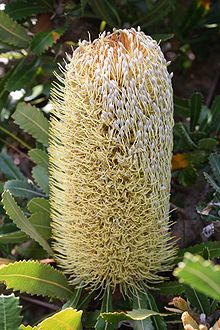
Back بنكسية منشارية Arabic بانكسيا منشاريه ARZ Banksia serrata Azerbaijani Banksia serrata Catalan Banksia serrata CEB Banksia serrata Spanish بانکسیا پیرمرد Persian Banksia serrata French Banksia serrata Hungarian Banksia serrata Italian
| Saw banksia | |
|---|---|

| |
| At Villa Durazzo-Pallavicini | |
| Scientific classification | |
| Kingdom: | Plantae |
| Clade: | Tracheophytes |
| Clade: | Angiosperms |
| Clade: | Eudicots |
| Order: | Proteales |
| Family: | Proteaceae |
| Genus: | Banksia |
| Subgenus: | Banksia subg. Banksia |
| Section: | Banksia sect. Banksia |
| Series: | Banksia ser. Banksia |
| Species: | B. serrata
|
| Binomial name | |
| Banksia serrata | |

| |
| Range of Banksia serrata in green | |
| Synonyms[1] | |
|
Alphabetical list
| |




Banksia serrata, commonly known as the saw banksia,[2] the old man banksia,[3] the saw-tooth banksia or the red honeysuckle and as wiriyagan by the Cadigal people, is a species of woody shrub or tree of the genus Banksia, in the family Proteaceae. Native to the east coast of Australia, it is found from Queensland to Victoria with outlying populations on Tasmania and Flinders Island. Commonly growing as a gnarled tree up to 16 m (50 ft) in height, it can be much smaller in more exposed areas. This Banksia species has wrinkled grey bark, shiny dark green serrated leaves and large yellow or greyish-yellow flower spikes appearing over summer. The flower spikes, or inflorescences, turn grey as they age and pollinated flowers develop into large, grey, woody seed pods called follicles.
B. serrata is one of the four original Banksia species collected by Sir Joseph Banks in 1770, and one of four species published in 1782 as part of Carolus Linnaeus the Younger's original description of the genus. There are no recognised varieties, although it is closely related to Banksia aemula. Throughout its range, it grows exclusively in sandy soil, and is usually the dominant plant in scrubland or low woodland. B. serrata is pollinated by and provides food for a wide array of vertebrate and invertebrate animals in the autumn and winter months, and is an important source of food for honeyeaters. It is a common plant of parks and gardens.
- ^ a b "Banksia serrata". Australian Plant Census. Retrieved 6 July 2019.
- ^ Cite error: The named reference
RBGSwas invoked but never defined (see the help page). - ^ "Old man banksia". NSW National Parks and Wildlife Service. Retrieved 17 November 2020.